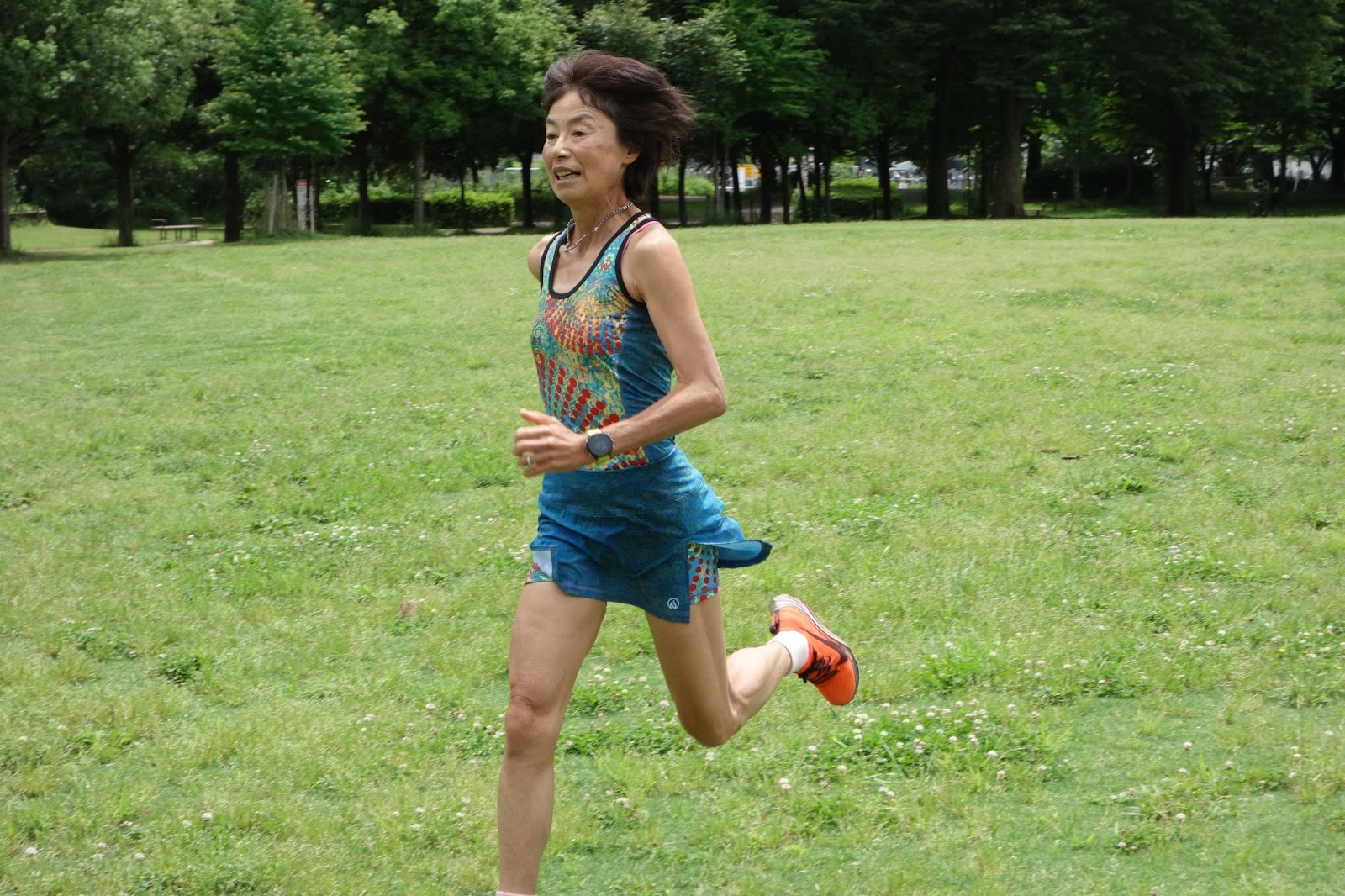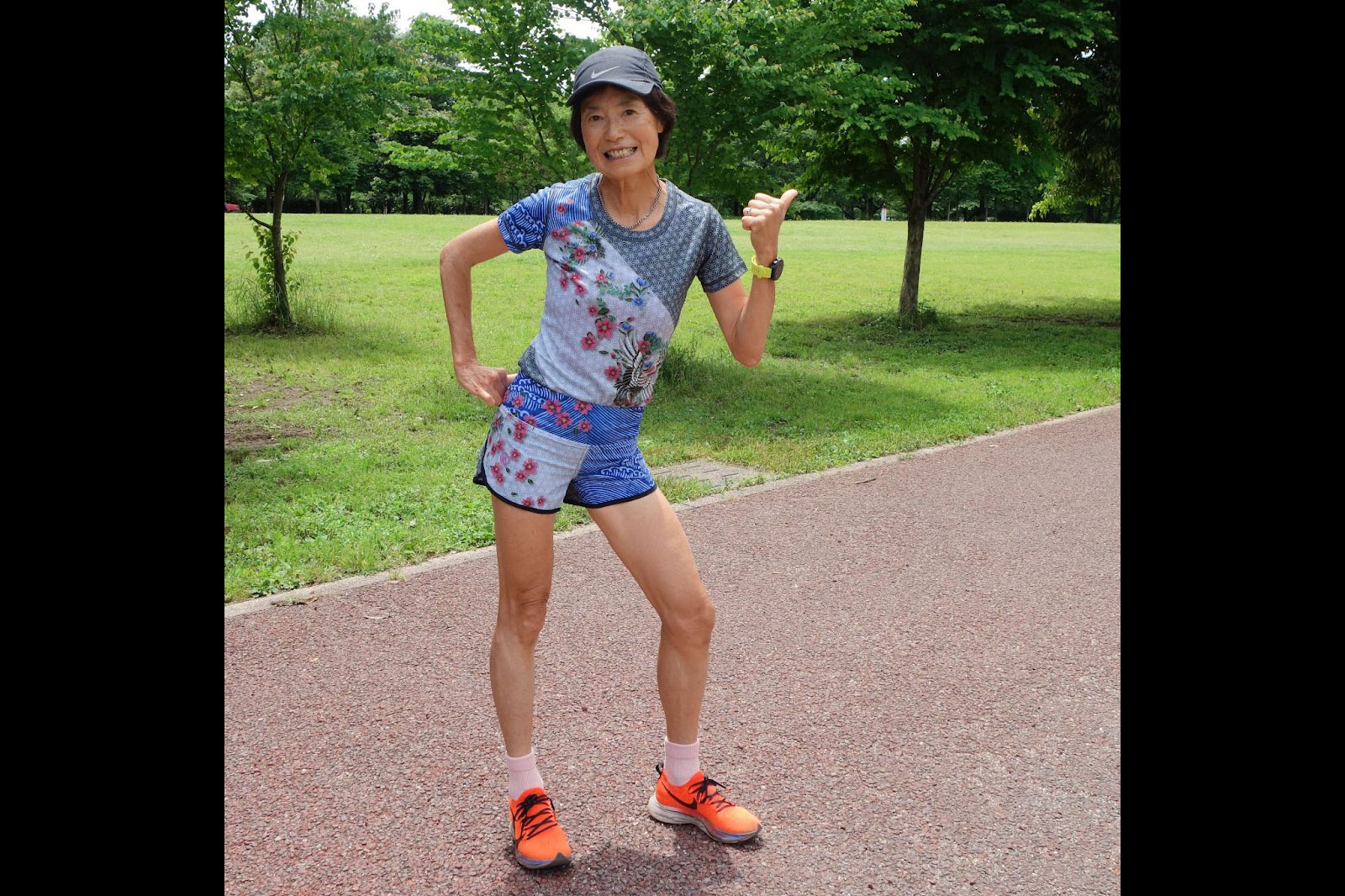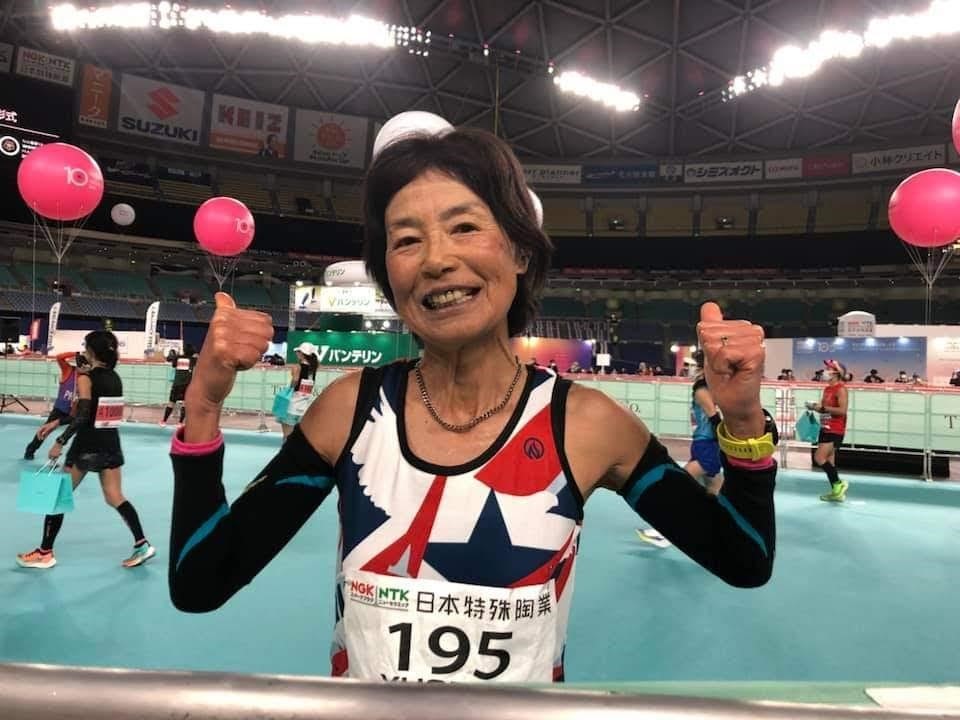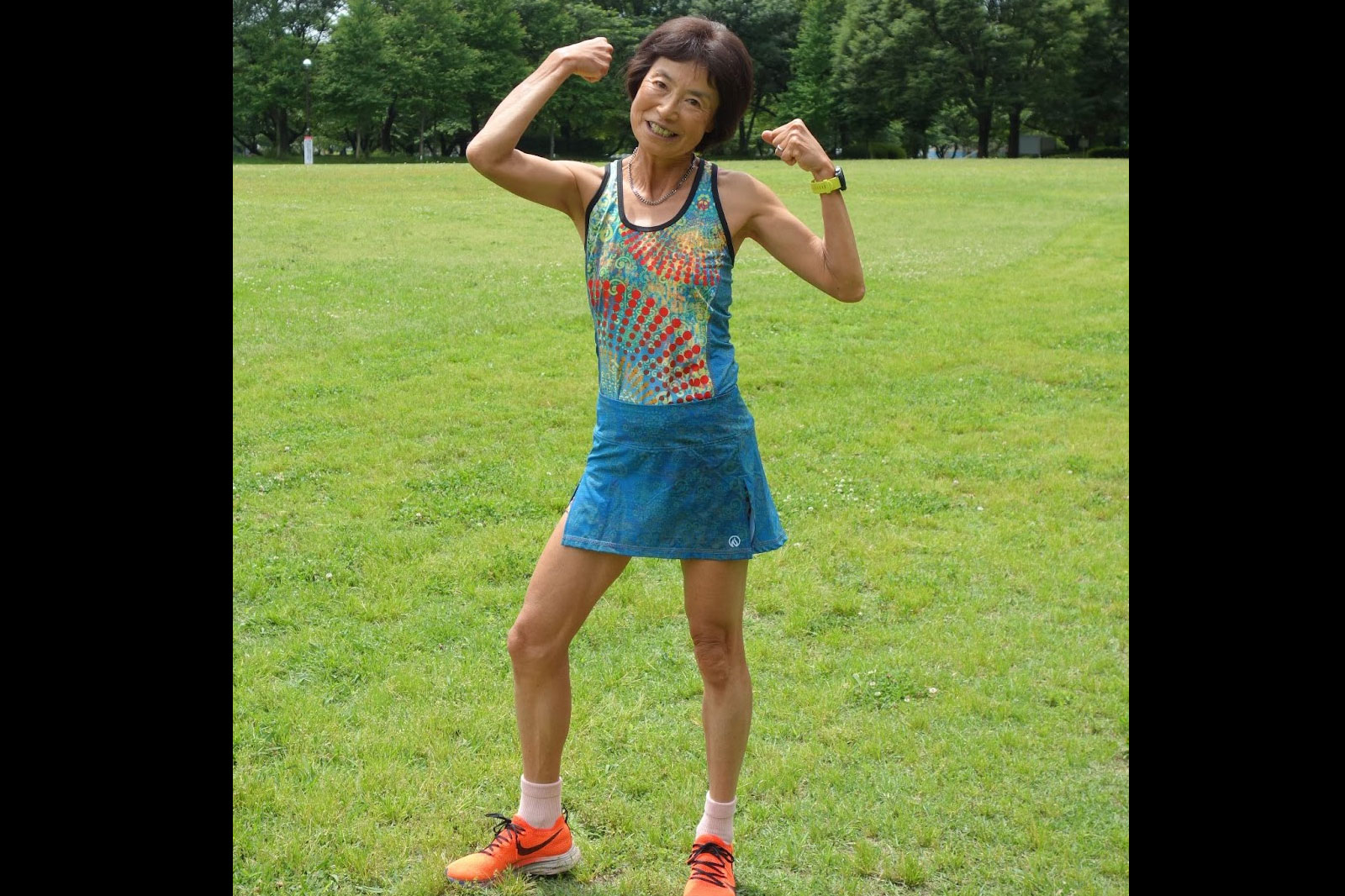INKspiration: Mariko Yugeta Sub 3 Marathon at 62!
Posted by Tamra Hood on Oct 27th 2021

When we think of being in our sixties and beyond, athletes often wonder what we will be capable of achieving. Will we continue to enjoy our favorite activities? Will we still want to run, practice yoga, and ride our bikes? Or will we decide it’s time to leave the ultramarathons and rock climbing in the past?
While most of us plan to continue to live an active lifestyle (most of us who enjoy INKnBURN are athletes, after all!), we often limit ourselves with the assumption that our physical abilities may be lesser than those of our younger years. Although we hope to stay active, maybe some of us are thinking of slowing down or even hanging up our running shoes for good.
But let’s imagine a different possibility. What if we considered our sixties and beyond the time to meet physical goals we didn’t have the time for or fitness to achieve in our younger years? Perhaps this part of our life is a great opportunity to start planning to run a race on every continent, train to hike the 500-mile Camino de Santiago through Spain, or decide to swim the entirety of Lake Tahoe.
Or maybe, if you’re like Mariko Yugeta, you decide it’s time to break records and become the first woman over 60 to run a marathon in less than three hours. Then you decide that simply breaking 3:00 isn’t enough… so you train and set a personal PR at the Osaka International Women’s Marathon and run a full 26.2 miles in 2:52:13 at 62 years old.
Yes, you read that correctly. While countless numbers of us are battling to break the 4:00 and 5:00 marathon time in our 20s and 30s, we were getting lapped by a woman who has showed the world that with the right lifestyle and training regimen, a PR is absolutely possible well beyond what many of us have limited ourselves to believing. We’re not sure about you, but learning this made us feel a little better about our inability to even finish a marathon during what we’ve been taught to believe is a peak time for runners.
Imagine our delight when we learned that this incredible, inspiring woman also happens to be a proud INKnBURN wearer! Obviously, we’re biased… but we think this beautiful woman looks amazing in our clothes.
Naturally, we had roughly 700 questions we wanted to ask Mariko, but we decided to narrow it down to a more… reasonable number so that she could get back to training for her next goal. We are so grateful and excited that she took the time to answer them for us!
When did you develop a love for running?
I have always liked running since I was little, and I always received the first prize at school sport events!
In junior high, I had to choose a sports activity group. At the time, I had a crush on a boy, and I wanted to do the same sport as him. So, I asked my friend to find out which sport group he was going to join, and I heard he was joining the runners' group so I joined them, too. However, I noticed the boy wasn't there after I joined the group! He had joined the Kendo group instead. I was not able to quit the runners' group once I joined them because I was afraid that the older members of the group may harass me... and this experience pushed me to open the door to the runners' world.
Could you describe your relationship with running?
Running became something necessary in my life, just like eating or sleeping. There is not even one day that I don't run. It's a part of my everyday life. I run even when I feel a little tired. Sometimes I run so slow that it’s almost like walking.
What are your favorite things about running?
When you work hard and get the fastest record in history at a difficult race, it is a fantastic feeling! This year in January, I broke my own fastest record. After I finished the race, I couldn't help crying because I felt so emotional.
What is your favorite running or training distance?
I often run 20 to 30K for training. My goal is to win first place in the world in my age group in a full marathon, so I run long distances for training. I especially like to run in the mountains. Mountain hills are better for training than running in a flat areas. I imagine runners in Ethiopia or Kenya probably have been running in the mountains since childhood to train themselves to be stronger, so I am trying to do the same.
Favorite race distance?
I think I do best in full marathons and half marathons.
How do you prepare for a marathon? Do you follow a specific training plan?
Right now, I am training to run in the Tokyo Marathon, which is my biggest goal. Basically, twice a week I train for particular skills. I train so that I have better control over my speed; for example, when to use intervals while racing and how to manage my running paces. Other than that, I jog. As I mentioned earlier, I jog in the mountains for long distances. It is important in a full marathon that you don't slow down after the first 30K, so I have trained myself to be able to run 50K in the mountains. My muscles ache so much after that.
What are your favorite races?
My favorite is the Tokyo Marathon! It gets so exciting! The supporters' cheering on the sides of the street is amazing. Everyone keeps cheering until the end without stopping! The music performance there is also awesome. I can run while enjoying the town of Tokyo, the capital of Japan, to the fullest! It's a flat course, so I can try to get a record fast speed.
What is your next running goal?
I want to finish The Tokyo Marathon race faster than 2:50. The race is on October 17th this year. That is my latest dream. Before this race, I am going to try to break the world record in my age group in the Ichinoseki Half Marathon in September. Those two races are my main events this year.
How are you training differently to reach your next goal?
I decided to train to run a longer distance than a full marathon because my legs had hard time handling races in the second half of a full marathon. Once a month, I go to the mountains where I feel relaxed and run 50K.
Now that we are all dropping our jaws in amazement (or is it just us? Because we kind of had to do a double take when we saw her next goal!), we wanted to know more about what Mariko does for a living. Is she a professional athlete? A trainer for Olympic marathoners? One of those trainers on the fancy treadmills that we all struggle to keep up with in our living room?
Nope to all the above.
What do you do for a living?
I teach at the high school that I graduated from. It's the happiest feeling to teach what I love there!
What inspired you to become a PE teacher?
When you are a high school student, you need to think about what you want to do when you are grown up, right? When I was in 11th grade, I had to decide which university I should try to go to. I thought I might become a pharmacist because I had frequent leg injuries. However, trying to get a degree to become a pharmacist is expensive. My parents asked me to go to a national university, which is less expensive, but it's pretty difficult to get accepted at national universities. I wasn’t sure what to do, but then my school teacher said, "Why don't you go to Saitama University (a national university) and be a PE teacher?" I thought "Oh... I see". This gave me the idea to become a PE teacher. I was accepted into Saitama University and got my teaching degree there.
Do your students know that you are a marathon runner?
Today, you can get all sorts of information about anything so easily, so students do know I am a runner. I also run when I teach PE classes, so my students know I run a lot. I also race seriously with my track and field students after school.
What running advice do you give to your students?
If I were to give a message to my students, it would be that it may be hard while you’re running, but reaching your goals is the best feeling ever! I would like my students to experience the best feelings that I am experiencing.
We have no doubt that Mariko is, in fact, the PE teacher we all wish we had as students!
For those of us who have never seen ourselves breaking records beyond one involving Netflix or most potato chips being consumed following a sweaty workout session, we’re suddenly realizing that maybe we actually can achieve a goal we never thought possible. So we wanted to pick her brain on running advice, mental training, and cross training as adults.
What advice would you give to other adults trying to reach their own running goals?
It is difficult to achieve a goal when you are running all by yourself. It's better to join a running group and have fun with your friends there. Even hard practices can be fun that way. Your runner friends can give you advice, too. Also, when you see social media posts by your running competitors, it can be motivating to run more and better. I am using Facebook for that reason!
Another thing to try is to have a small goal before making a huge one, such as participating in a rather small race. In my case, if I plan to participate in a full marathon in autumn, then I try to run in a 10K in summer, or even a half marathon race before the big event. Doing such a thing helps motivate you for your next bigger goal.
How do you push through the difficult mental moments of a race?
During a race, I try to think about the next refreshment point if it feels pretty difficult. Such as, “Oh, I can have some energy gel in about 1K,” or, “I can eat something sweet, and I can drink sports drinks.” When I do this, I know I can get through it eventually. Also, if I see another runner in front of me, I try to keep up with her and follow her.
Do you do any other sports or activities?
I play sports with my students. My favorite is dancing! You have to do the same physical movement when running, but you can move your entire body when dancing, which is really good for your body. It can be beneficial for running in a marathon. And also, Ping-Pong is fun! In Japan, hotels in hot spring resort areas often have Ping-Pong tables for the visitors. You wear Yukata and play Ping-Pong with family after dinner. It is really fun!
Finally, we of course needed to know how she discovered our California-born-and-raised business. It’s always such an honor to see people from all around the world wearing our colorful designs that we take so much pride in creating!
How did you discover INKnBURN?
A friend of mine gave me an INKnBURN singlet for my birthday last year to congratulate me for my new running world record.
What’s your favorite thing about INKnBURN?
When I put it on for the first time, I noticed it was very light and easy to move around in! I personally think arm swinging is very important in running, and it's very easy to swing my arms in the singlets. Not only that, but you get this super excited feeling when you put it on! My husband and my students told me that I look good in it. And I like that I can put an energy gel in the pockets. When I went for my most recent 50K training, I had two energy gels in my pockets. So convenient!
Do you have a favorite INKnBURN piece?
I like the Statue of Liberty singlet. I also like Sakura design and Tokyo design. As for the bottoms, I like floral designs. I like pink, so I like the colorful flowers on them. When I put on colorful, flashy gear, it really gets me running like crazy! As I get a little older, I seem to enjoy colorful designs more.
Mariko, we think you look spectacular in our gear!
Well, we don’t know about you, but it looks like it’s time for us to reevaluate some of our running goals because we now know that we are capable of achieving so much more than we thought possible!
Thank you so much for sharing your story and advice with us, Mariko. Hearing your words of wisdom is seriously motivating! We can’t wait to cheer for you in your upcoming races!
Author’s Note: Original quotes have been translated from Japanese to English. I did my best to maintain the integrity of Mariko’s words, but there is always a chance that context was unintentionally lost in translation. My sincere gratitude to Mari and Yuko for your help in translating from English to Japanese and back again! I couldn’t have done this without your help. - Tamra Hood
Translation by Mari Freeman and Yuko Saito Sawai

